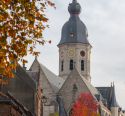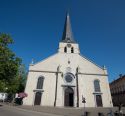Temse: 'Heilig Harnas'
Welcome to the land of trousers, mud flats and salt marshes. The rivers Durme and Scheldt have proven to be a blessing, but just as often a curse! Floods were commonplace. The Church and abbeys often acted as protectors.
Building dikes to secure the floodplains into cultivable polders helped to reassure the inhabitants. Measures accompanied, on the spiritual level, by the cult of the water saint Amelberga and the construction of many chapels. It is also the region of the beatified priest Poppe who defended the poor and the young.
The cycle route starts in Temse and goes via the dike to Tielrode. The ferry takes you to the Hamme region, where you can reach Kastel via a piece of unspoilt nature. You will stop in picturesque Moerzeke and then go after Hamme. Via the voluptuous Miraburg you will cross the Durme again to return to Temse.
Our cycling brochure (NL) is available free of charge at the Tourist Services of Temse and Hamme and in Our Lady's Church in Temse, Pius-Poppe Chapel in Moerzeke and in the St. Peter's Band Church in Hamme. Hop on your bike and be surprised by the religious heritage in this beautiful region!
Continue on PC Download PDF Continue on mobile
-
Priester Poppe Museum – Temse
Edward Poppe (1890-1924), from the time he was ordained a priest, was successively a vicar at the St. Coletaparochie in Ghent, director of the Sisters of St. Vincent de Paul in Moerzeke and spiritual director of the Cibists (clergymen who perform their military service) in Leopoldsburg (...)
-
Onze-Lieve-Vrouw Church – Temse
Temse: Oldest parish of the Waasland. Temse is said to have been christianised before 772 by Saint Amelberga. She is still very popular in Temse, among others because of the St. Amelberga guild who organizes the Wegom three times a year (...)
-
Sint-Jozef Chapel – Tielrode
Tielrode was connected to the Abbey of Lobbes in Thuin for a long time. To a large extent they would have been responsible for the swamp remediation of the village and the Tielrodebroek. The Saint Joseph Chapel is a remnant of the former parish church of Tielrode (...)
-
Sint-Petrus Church – Tielrode
The new church of Tielrode was built between 1904-1906 according to the plans of the Ghent architect H. Geirnaert. It was designed in the late neo-gothic period. The old church was all too often plagued by the continuous flooding of the Durme, which led to the decision to build it further inland (...)
-
Sint-Jozef Church – Kastel
The hamlet of Kastel is surrounded on three sides by the Scheldt. Initially it was a swampland with some heights such as the Ganzenberg and Stuyfbergen that was flooded daily by the tides. In the 13th century the lord of Moerzeke appealed to the abbey of Hemiksem, one of the richest abbeys in Western Europe, to preserve Kastel from floods (...)
-
Sint-Martinus Church – Moerzeke
The history of the Moerzeke church dates back at least to the 12th century when it was still in the possession of St Bavo's Abbey in Ghent. When the seigniory of Moerzeke was bought in 1755 by jonkheer Emmanuel A.J. Van den Meersche it was decided to demolish the old church and to replace it with a classicistic church (...)
-
Priest Poppe Chapel – Moerzeke
On the domain of the old feudal court of the lords of Moerzeke stands the burial chapel of Priest Poppe. The enthusiastic priest died in 1924 at the age of 34 in Moerzeke. His grave at St Martin's church quickly became a popular place of pilgrimage (...)
-
Schoeless Carmelites Convent - Moerzeke
The community of Carmelites from Dendermonde moved to Moerzeke in 1976. There are only 11 monasteries of Carmelites or Theresians in Flanders. Following the example of Saint Theresa of Avila, they live in total solitude in order to be able to devote themselves entirely to prayer (...)
-
Windmill ‘Grote Napoleon’ – Hamme
The 'Grote Napoleon' is the only complete mill that remains of the 22 mills that Hamme was once rich. It dates from 1816 and was rebuilt in 1976-1977. At the mill there is now a traditional bakery, ice-cream parlour and museum (...)
-
Sint-Pietersbanden Church – Hamme
Hamme would have had the first stone church in this part of Flanders. It was already mentioned before the 10th century. Due to the growth of the population it was decided to completely rebuild and enlarge the old church in 1740 (...)
-
Winter Chapel – Hamme
The Winter Chapel originally belonged to the former St Vincent's Monastery. The chapel dates from 1871. Work of alteration was carried out around 1903. In this period, the chapel was also used as a winter chapel (...)




